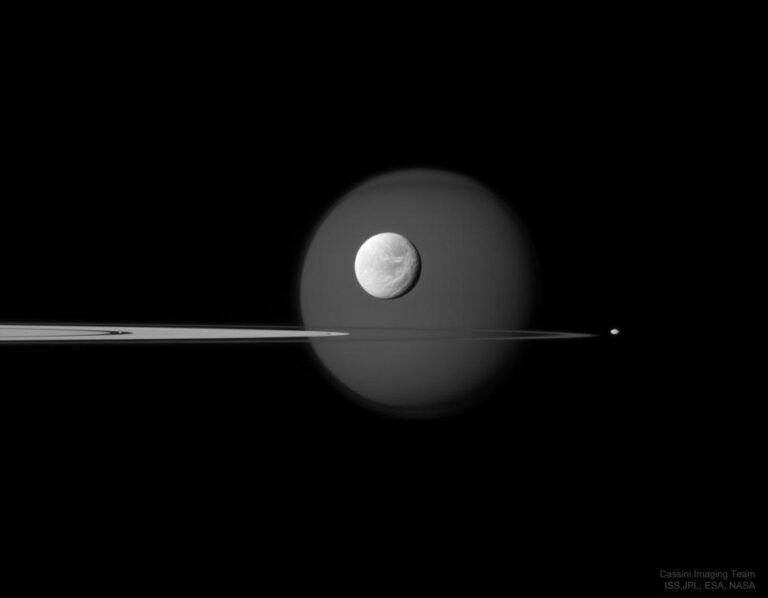土星的夜晚
See Explanation. Clicking on the picture will download the highest resolution version available.
请参阅说明。单击图片将下载可用的最高分辨率版本。

See Explanation. Clicking on the picture will download the highest resolution version available.
请参阅说明。单击图片将下载可用的最高分辨率版本。

詹姆斯·韦伯太空望远镜的NIRCam仪器于2023年6月25日拍摄的土星及其部分卫星的图像。在这张单色图像中,NIRCam滤波器F323N(3.23微米)用橙色色调进行颜色映射。从太空望远镜科学研究所下载带注释和未注释的全分辨率图像。 影像来源:NASA, ESA, CSA, STScI, M. Tiscareno (SETI Institute), M. Hedman (University of Idaho), M. El Moutamid (Cornell University), M. Showalter (SETI Institute), L. Fletcher (University of Leicester), H. Hammel (AURA); 由J. DePasquale (STScI)进行图像处理 2023年6月25日,NASA的詹姆斯·韦伯太空望远镜转向著名的土星环,首次对这颗行星进行近红外观测。韦伯的NIRCam(近红外相机)的初始图像已经吸引了研究人员。 在望远镜观察到的红外波段,土星本身看起来非常暗,因为甲烷气体吸收了几乎所有落在大气层上的阳光。然而,冰环保持相对明亮,导致土星在韦伯图像中出现不寻常的外观。 这张照片是韦伯保证时间观测计划1247的一部分。该项目包括几次对土星的深度曝光,目的是测试望远镜探测土星周围微弱卫星及其明亮光环的能力。任何新发现的卫星都可以帮助科学家们更完整地了解土星目前的系统及其过去。 这张新的土星照片清楚地显示了土星环系统的细节,以及土星的几个卫星——土卫四、土卫二和土卫三。额外的深度曝光(此处未显示)将使研究团队能够探测该行星上一些较暗的环,这些环在这张图片中不可见,包括薄的G环和弥漫的E环。土星环由一系列岩石和冰碎片组成——这些颗粒的大小从比沙粒小到像地球上的山脉那么大。研究人员最近利用韦伯探索土卫二,并发现从土卫二南极喷射出一股巨大的羽流,其中既有粒子,也有大量的水蒸气——这股羽流为土星的E环提供了原料。 土星的大气层也显示了令人惊讶和意想不到的细节。尽管卡西尼号宇宙飞船以更高的清晰度观测到了土星的大气层,但这是首次在这种特定波长(3.23微米)上以这种清晰度观测到这颗行星的大气,这是韦伯望远镜所独有的。北半球巨大、黑暗、弥散的结构并不遵循这颗行星的纬度线,因此这张图像缺少通常从土星较深的大气层看到的熟悉的条纹外观。这些斑块让人联想到主云上方高空平流层气溶胶中的大规模行星波,可能类似于早期韦伯NIRCam对木星的观测。 当比较这张照片中的土星北极和南极时,外观上的差异是已知的土星季节性变化的典型特征。例如,土星目前正处于北半球的夏季,南半球在冬季结束时从黑暗中出现。然而,北极特别黑暗,可能是由于一个未知的季节性过程,特别是影响极地气溶胶。土星盘边缘的微弱光亮可能是由于高空甲烷荧光(吸收光后发光的过程)、电离层中三氢离子(H3+)的发射,或者两者兼而有之;韦伯的光谱学可以帮助证实这一点。 几十年来,NASA的先驱者11号、旅行者1号和2号、卡西尼号航天器和哈勃太空望远镜等任务一直在追踪土星的大气层和土星环。韦布的这些观测只是一个暗示,随着科学团队深入研究数据以准备同行评审的结果,该天文台将在未来几年为土星的故事增添什么。 科学数据来源 NASA, ESA, CSA, STScI, Matt Tiscareno (SETI Institute), Matt Hedman (University of Idaho), Maryame El Moutamid (Cornell University), Mark Showalter (SETI Institute), Leigh Fletcher (University of Leicester), Heidi Hammel (AURA) 影像处理来源 J. DePasquale (STScI) 关于作者 海蒂·B·哈梅尔是韦伯望远镜的跨学科科学家,负责韦伯望远镜对太阳系的第一周期保证时间观测(GTO)计划。她是华盛顿特区天文学研究大学协会(AURA)的科学副主席。 利·弗莱彻是英国莱斯特大学的行星科学教授。利是几个韦伯保证时间观测项目的首席研究员,包括这里强调的1247项目。 麦特·提斯凯尔诺是加州SETI研究所的高级研究科学家,他在那里研究包括行星环在内的行星系统的动力学。他是韦伯保证时间观测团队研究土星的重要成员。 图像的未标注版本: 从太空望远镜科学研究所下载带注释和未注释的全分辨率图像。 参考来源: https://blogs.nasa.gov/webb/2023/06/30/saturns-rings-shine-in-webbs-observations-of-ringed-planet/

2022年12月23日 Cassini Looks Out from Saturn Image Credit: NASA, JPL-Caltech, Space Science Institute Explanation: This is what Saturn looks like from inside the rings. In 2017, for the first time, NASA directed the Cassini spacecraft to swoop between Saturn and its rings. During the dive, the robotic spacecraft took hundreds of images showing unprecedented detail for structures in Saturn’s atmosphere. Looking back out, however, the spacecraft was also able to capture impressive vistas. In the featured image, taken a few hours before closest approach, Saturn’s unusual northern hexagon is seen surrounding the North Pole. Saturn’s B ring is the closest visible, while the dark Cassini Division separates B from the outer A. A close inspection will find the two small moons that shepherd the F-ring,…

2022年11月26日 Saturn at Night NASA, JPL-Caltech, Space Science Institute, Mindaugas Macijauskas Explanation: Saturn is still bright in planet Earth’s night skies. Telescopic views of the distant gas giant and its beautiful rings often make it a star at star parties. But this stunning view of Saturn’s rings and night side just isn’t possible from telescopes closer to the Sun than the outer planet. They can only bring Saturn’s day into view. In fact, this image of Saturn’s slender sunlit crescent with night’s shadow cast across its broad and complex ring system was captured by the Cassini spacecraft. A robot spacecraft from planet Earth, Cassini called Saturn orbit home for 13 years before it was directed to dive into the atmosphere of the gas giant on…

2021年04月04日 In, Through, and Beyond Saturn’s Rings Image Credit: Cassini Imaging Team, ISS, JPL, ESA, NASA Explanation: Four moons are visible on the featured image — can you find them all? First — and farthest in the background — is Titan, the largest moon of Saturn and one of the larger moons in the Solar System. The dark feature across the top of this perpetually cloudy world is the north polar hood. The next most obvious moon is bright Dione, visible in the foreground, complete with craters and long ice cliffs. Jutting in from the left are several of Saturn’s expansive rings, including Saturn’s A ring featuring the dark Encke Gap. On the far right, just outside the rings, is Pandora, a moon only 80-kilometers…

2020年8月8日 Crescent Saturn Image Credit: NASA, ESA, SSI, Cassini Imaging Team Explanation: From Earth, Saturn never shows a crescent phase. But when viewed from a spacecraft the majestic giant planet can show just a sunlit slice. This image of crescent Saturn in natural color was taken by the robotic Cassini spacecraft in 2007. It captures Saturn’s rings from the side of the ring plane opposite the Sun — the unilluminated side — another vista not visible from Earth. Visible are subtle colors of cloud bands, the complex shadows of the rings on the planet, and the shadow of the planet on the rings. The moons Mimas, at 2 o’clock, and Janus 4 o’clock, can be seen as specks of light, but the real challenge is…

2019 December 29 Cassini Spacecraft Crosses Saturn’s Ring Plane Image Credit: NASA, ESA, JPL, ISS, Cassini Imaging Team; Processing: Fernando Garcia Navarro Explanation: If this is Saturn, where are the rings? When Saturn’s “appendages” disappeared in 1612, Galileo did not understand why. Later that century, it became understood that Saturn’s unusual protrusions were rings and that when the Earth crosses the ring plane, the edge-on rings will appear to disappear. This is because Saturn’s rings are confined to a plane many times thinner, in proportion, than a razor blade. In modern times, the robot Cassini spacecraft orbiting Saturn frequently crossed Saturn’s ring plane during its mission to Saturn, from 2004 to 2017. A series of plane crossing images from 2005 February was dug out of…

2019 November 3 Daphnis and the Rings of Saturn Image Credit: NASA, JPL-Caltech, Space Science Institute, Cassini Explanation: What’s happening to the rings of Saturn? A little moon making big waves. The moon is 8-kilometer Daphnis and it is making waves in the Keeler Gap of Saturn’s rings using just its gravity — as it bobs up and down, in and out. The featured image is a colored and more detailed version of a previously released images taken in 2017 by the robotic Cassini spacecraft during one of its Grand Finale orbits. Daphnis can be seen on the far right, sporting ridges likely accumulated from ring particles. Daphnis was discovered in Cassini images in 2005 and raised mounds of ring particles so high in 2009…